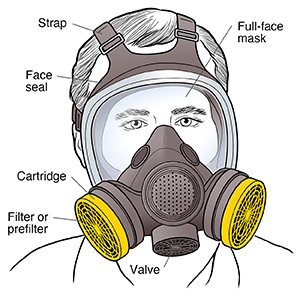Understanding Respirators
A respirator is a device to protect you from inhaling dangerous substances, such as chemicals and infectious particles.
These respirators do not supply oxygen from any other source except the working atmosphere. Therefore, they cannot be used in an atmosphere that is oxygen-deficient or immediately dangerous to life or health.
To get the best protection from a respirator, you need to learn about its different parts. When used, maintained, and replaced correctly, the parts of a respirator can lessen your exposure to nearby hazards.

-
Straps hold the mask snugly in place.
-
A face seal keeps contaminants out of the mask.
-
A cartridge is a container with a filter, sorbent, catalyst, or combination of these items that removes specific contaminants from the air passed through the container. It captures certain gases and vapors.
-
A filter or prefilter is a component used in respirators that removes solid or liquid aerosols from the inhaled air. It traps particles.
-
A full-face mask adds eye protection.
-
A valve opens when you exhale and closes when you inhale.
The full facepiece covers roughly from the forehead to below the chin. These types of respirators tend to provide a more reliable face seal. Since these respirators cover the user’s face and eyes, they can also be used to protect against liquid splashes and irritating vapors.
Filtering out the hazards
Cartridges trap gases and vapors. Filters trap particles. All cartridges, filters, and prefilters must be certified by NIOSH (National Institute for Occupational Safety and Health). NIOSH rates filters on a scale of 3 efficiency levels. These are 95%, 99%, and 99.97%. The minimal level of filtration that will be approved by NIOSH is 95%. Within these efficiency levels are 3 filter types. These are N, R, and P. This classification refers to how effective a filter works when exposed to oils:
-
N filters. These are used when there are no oily particles. They are not resistant to oils.
-
R filters. These can be used to protect against oily particles. They are somewhat resistant to oils.
-
P filters. These provide the highest level of safety against all particles. They are strongly resistant to oils.
When to replace filters and cartridges
Follow instructions from your supervisor or the respirator manufacturer to learn when to replace your prefilter, filter, or cartridge.
When cleaning and sanitizing a respirator, follow the manufacturer’s guidelines. should always be followed. Check the manufacturer’s website if guidance is not included with the packaging of the respirator.